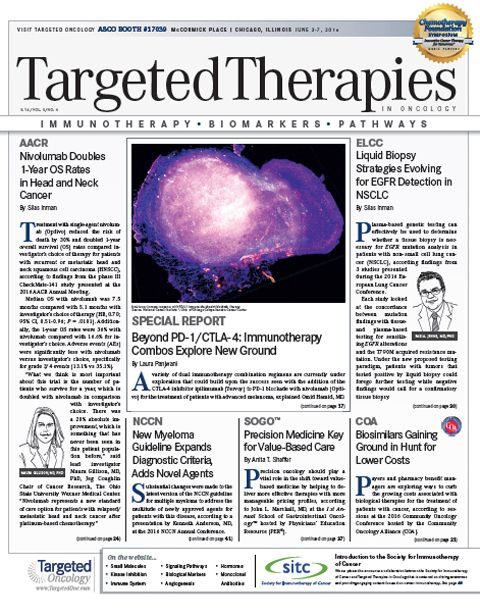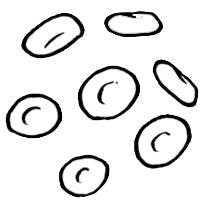NCCN Tweaks Breast Cancer Recommendations
A number of small changes that were specific to neoadjuvant and adjuvant therapies were made to the NCCN breast cancer guidelines, additionally, the recommended treatments for patients with ER-positive disease were also modified.
William J. Gradishar, MD
A number of small changes that were specific to neoadjuvant and adjuvant therapies were made to the NCCN breast cancer guidelines, additionally, the recommended treatments for patients with ERpositive disease were also modified, according to William J. Gradishar, MD.
“We made [guideline] modifications suggesting that endocrine therapy can be used selectively in the preoperative setting for patients with ER+ disease,” Gradishar, a professor of Breast Oncology at the Feinberg School of Medicine at Northwestern University, said at the 2016 NCCN Annual Conference.
The most suitable patients for neoadjuvant endocrine therapy are patients with ER rich cancers who are older (postmenopausal), or if they are younger, those who have significant comorbidities that make them poor candidates for chemotherapy.
The multicenter, open-label phase III ACOSOG Z1031 study randomized women with stage II/III ER-rich (Allred score 6-8) breast cancer to 16 weeks of neoadjuvant treatment with exemestane, letrozole, or anastrozole.1The clinical response rate ranged between 60% and 72% among the 3 treatment arms.
“These data were primarily in postmenopausal women, but if you were to treat a premenopausal woman with an aromatase inhibitor [AI], you would obviously have to render her postmenopausal with ovarian suppression ablation before doing so,” said Gradishar.
Gradishar also noted that neoadjuvant chemotherapy with or without antiHER2 therapy is increasingly successful in producing pathologic complete responses (pCRs), but only in ER-negative/HER2-positive cancers.
He cited the pivotal phase II NeoSphere trial,2which showed that pertuzumab (Perjeta), combined with trastuzumab (Herceptin) and docetaxel, significantly improved pCR when compared with 3 other neoadjuvant regimens (trastuzumab plus docetaxel, pertuzumab plus trastuzumab, or pertuzumab plus docetaxel) in newly diagnosed patients with HER2-positive, early-stage breast cancer. These data, along with other reports, led to the FDA approval of the pertuzumab regimen.
In each of the 4 cohorts in the NeoSphere trial, pCR was higher among patients who were HR-negative. Gradishar stressed that pCR in ER-positive patients may not effective at predicting outcomes.
In a study by Ring et al3of 435 patients who received neoadjuvant chemotherapy for operable breast cancer, overall survival (OS) outcomes were improved in patients who achieved a pCR compared with those who did not (5-year OS, 91% vs 73%; P = .02). This correlation held up in ER-negative patients (5-year OS, 90% vs 52%; P = .005), but pCR did not have prognostic significance in ER-positive patients (5-year OS, 93% vs 79%; P = .3).
ADJUVANT ENDOCRINE THERAPY IN PRE- AND POSTMENOPAUSAL WOMEN
The NCCN guidelines stipulate that for premenopausal women at diagnosis, the optimal adjuvant endocrine therapy is tamoxifen for 5 years with or without ovarian function suppression (OFS) or an AI for 5 years with OFS.
If a patient becomes postmenopausal after 5 years, physicians should consider tamoxifen for an additional 5 years or switch to an AI for 5 years. If a patient remains premenopausal, physicians should consider tamoxifen for an additional 5 years or no further endocrine therapy.
“In postmenopausal women [at diagnosis] we have several different options, that include tamoxifen to start, switching over [to an AI] at some point, or, really what we view as the standard for most women, is to start with an AI,” said Gradishar. “And, again, the data for an AI beyond 5 years is really limited at this point...as it stands at this point we would say that 5 years of an AI is the optimal duration.”
Gradishar cited a combined analysis of the ATLAS and aTTom trials,4which examined the long term-impact of tamoxifen in women with early-stage, ER+ great cancer.
The combined data showed that in years 5 through 9, the impact of tamoxifen was not evident, with an HR for breast cancer mortality of 0.97 and an HR for OS of 0.99. However, in years 10 and beyond, tamoxifen was associated with a 25% reduction in the risk of breast cancer mortality (HR, 0.75) and a 16% improvement in OS (HR, 0.84).
“So we have justification for using longer durations of therapy based on this data set,” said Gradishar.
ROLE OF OVARIAN FUNCTION SUPPRESSION
There have also been efforts made by the NCCN guideline panelists to consider the appropriate use of OFS in premenopausal women with ER+ and/or PR+ breast cancer.
Gradishar said physicians should consider use of OFS plus tamoxifen or OFS plus an AI in patients aged <35 years who need chemotherapy (ie, greater risk of recurrence), who remain premenopausal, and who have larger, higher-grade tumors with multiple positive nodes. He added that the optimal duration of OFS-based therapy is uncertain, but suggested a trial period of 3 to 5 years.
The recommendations are based on outcomes from the SOFT and TEXT trials. The SOFT trial included 3047 premenopausal women with early HR+ breast cancer randomized to 5 years of tamoxifen or OFS added to either tamoxifen or exemestane. The TEXT trial randomized 2672 premenopausal women with HR+ breast cancer to tamoxifen plus OFS for 5 years or exemestane plus OFS for 5 years.
A joint analysis of the TEXT and SOFT trials showed that exemestane plus OFS improved outcomes versus tamoxifen plus OFS in terms of disease-free survival (HR, 0.72; P = .0002), breast cancer-free interval (HR, 0.66; P <.0001), and distant disease-free interval (HR, 0.78; P = .02).5However, OS was the same between the 2 regimens (HR, 1.14; P = 0.37).
Despite the benefit, several grade 3/4 AEs were higher with the exemestane versus the tamoxifen regimen, including musculoskeletal events (11% vs 5.2%) and dyspareunia (2.3% vs 1.4%). Exemestane was also associated with a higher incidence of vaginal dryness, loss of sexual interest, difficulty with arousal, and bone/joint pain.
For additional clarity, “long-term follow-up of the pivotal [TEXT and SOFT] trials for adherence, toxicity, and bene t is critical,” said Gradishar.
NEOADJUVANT HER2-TARGETED THERAPY
Gradishar said the ongoing critical question with neoadjuvant HER2positive treatment in breast cancer remains, “Does increasing pCR improve outcomes?”
The answer to this question remains unclear, Gradishar noted.
Findings from the NeoALTTO study,6showed that patients who achieved a pCR after receiving lapatinib (Tykerb) and trastuzumab as neoadjuvant therapy displayed a significantly higher rate of 3-year event-free survival, raising hopes that the adjuvant ALTTO trial would confirm those results.
However, in the ALTTO trial,7use of the lapatinib/trastuzumab regimen in the adjuvant setting for HER2positive early breast cancer failed to demonstrate a significant improvement in disease-free survival over standard therapy with trastuzumab alone.
The pertuzumab regimen was given an accelerated FDA approval in HER2positive, early-stage breast cancer, based on pCR findings from the phase II NeoSphere trial. The approval is contingent on the confirmatory phase III APHINITY trial, which is comparing pertuzumab, trastuzumab, and chemotherapy with trastuzumab and chemotherapy in the adjuvant setting for patients with HER2-positive early-stage breast cancer.
“If the adjuvant APHINITY trial proves not to be positive and does not represent what we’ve seen in the preoperative setting, the guidelines may change, but based on the data that we have available at this point, we feel that it’s a reasonable and prudent thing to offer [the neoadjuvant pertuzumab regimen] to patients,” Gradishar said.
He added that updated NeoSphere data presented at the 2015 ASCO Annual Meeting offered hope that the pCR benefit in the NeoSphere trial would accurately project a positive outcome with pertuzumab in APHINITY trial. The findings presented at ASCO showed that patients who received pertuzumab plus trastuzumab/docetaxel appeared to have the best improvement in progression-free survival (PFS) compared with the other arms, which was consistent with the pertuzumab triplet having the highest pCR in the initial analysis.8
NEW COMBINATIONS WITH ENDOCRINE THERAPY IN METASTATIC DISEASE
There is an increasing trend in breast cancer, and other malignancies, toward the combination therapies with varying mechanisms of action, not only in the frontline setting but also in the second- and third-line. This paradigm is established in HER2positive disease, and, now, with the introduction of CDK 4/6 inhibitors, this has begun to take shape for patients with ER+ disease.
“If you look at the guidelines over the last few years, the striking thing that changes is instead of having a series of monotherapy choice options, we start to see the introduction of targeted therapy in combination with endocrine therapy as a standard, whether it’s everolimus, palbociclib, or even combinations of endocrine therapy,” said Gradishar.
In February 2015, the FDA granted an accelerated approval to the CDK 4/6 inhibitor palbociclib (Ibrance) as a frontline treatment for postmenopausal women with ER-positive, HER2-negative metastatic breast cancer, based on findings from the phase II PALOMA-1 trial.9
In the open-label phase II study, treatment with palbociclib plus letrozole reduced the risk of disease progression by 51% compared with letrozole alone. The median PFS with palbociclib was 20.2 versus 10.2 months for letrozole alone (HR, 0.488; P = .0004).
Palbociclib was approved by the FDA in February 2016 for use in combination with fulvestrant in pretreated patients with HR-positive, HER2-negative metastatic breast cancer.
The approval was based on findings from the phase III PALOMA-3 trial,10in which adding palbociclib to standard fulvestrant more than doubled PFS in pretreated patients with HR-positive, HER2-negative breast cancer. Median PFS was 9.5 months with the palbociclib combination versus 4.6 months in the placebo arm (HR, 0.461; P <.0001).
Gradishar said this information is now included in the guidelines.
“We now have a series of different treatments. We have to, again, judge whether a patient is appropriate for combining endocrine therapy with these different kinds of agents, like palbociclib and everolimus, but I think that as we go forward, we are going to see more of this.”
References:
- Olsen JA, et al. Presented at: 2010 Breast Cancer Symposium; October 1-3, 2010; Washington, DC. Abstract 91.
- Gianni L, Pienkowski T, Im YH, et al. Efficacy and safety of neoadjuvant pertuzumab and trastuzumab in women with locally advanced, inflammatory, or early HER2-positive breast cancer (NeoSphere): a randomised multicentre, open-label, phase 2 trial.Lancet Oncol.2012;13(1):25-32.
- Ring AE, Smith IE, Ashley S, et al. Oestrogen receptor status, pathological complete response and prognosis in patients receiving neoadjuvant chemotherapy for early breast cancer.Br J Cancer.2004;91(12):2012-2017.
- Gray RG, Rea D, Handley K, et al. aTTom: Long-term effects of continuing adjuvant tamoxifen to 10 years versus stopping at 5 years in 6,953 women with early breast cancer.J Clin Oncol31, 2013 (suppl; abstr 5).
- Pagani O, Regan MM, Walley BA, et al. Adjuvant exemestane with ovarian suppression in premenopausal breast cancer.N Engl J Med.2014;371:107-118.
- Piccart-Gebhart M, Holmes AP, de Azambuja E, et al. The association between event-free survival and pathological complete response to neoadjuvant lapatinib, trastuzumab, or their combination in HER2-positive breast cancer. Survival follow-up analysis of the NeoALTTO study. Presented at: the 36th Annual San Antonio Breast Cancer Symposium; December 10-14, 2013; San Antonio, TX. Abstract S1-01.
- Piccart-Gebhart M, Holmes AP, Baselga J, et al. First results from the phase III ALTTO trial (BIG 2-06; NCCTG [Alliance] N063D) comparing one year of anti-HER2 therapy with lapatinib alone (L), trastuzumab alone (T), their sequence (T L), or their combination (T+L) in the adjuvant treatment of HER2-positive early breast cancer (EBC). Presented at: 2014 ASCO Annual Meeting Press Briefing; June 1, 2014; Chicago, IL. Abstract LBA4.
- Gianni L, Pienkowski T, Im Y-H et al. Five-year analysis of the phase II NeoSphere trial evaluating four cycles of neoadjuvant docetaxel (D) and/or trastuzumab (T) and/or pertuzumab (P).J Clin Oncol33, 2015 (suppl; abstr 505).
- Finn RS, Crown JP, Lang I, et al. The cyclin-dependent kinase 4/6 inhibitor palbociclib in combination with letrozole versus letrozole alone as first-line treatment of oestrogen receptor-positive, HER2-negative, advanced breast cancer (PALOMA-1/TRIO-18): a randomised phase 2 study.Lancet Oncol.2015;16(1):25-35.
- Cristofanilli M, Turner NC, Bondarenko I, et al. Fulvestrant plus palbociclib versus fulvestrant plus placebo for treatment of hormone-receptor-positive, HER2-negative metastatic breast cancer that progressed on previous endocrine therapy (PALOMA-3): final analysis of the multicentre, double-blind, phase 3 randomised controlled trial.Lancet Oncol.2016. pii: S1470- 2045(15)00613-0.


















